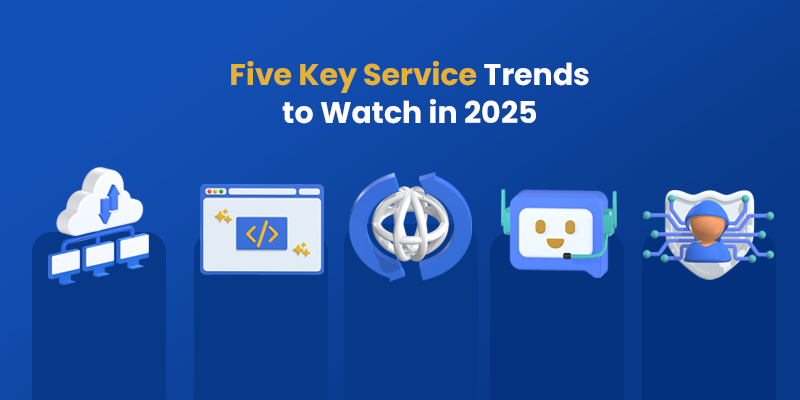The Future of IT: Five Key Service Trends to Watch in 2025
The IT services industry is evolving at an unprecedented pace, driven by rapid technological advancements, growing cybersecurity concerns, and the demand for automation and AI-driven solutions. As we step into 2025, businesses must stay ahead of these trends to remain competitive, secure, and efficient.
From AI-powered IT services to enhanced cybersecurity measures, this year is set to bring transformative changes that will redefine the IT landscape. In this blog, we’ll explore the top five IT service trends to watch in 2025 and how they will shape the future of businesses worldwide.
1. AI and Automation Will Dominate IT Services
Why It’s Important
Artificial Intelligence (AI) and automation are no longer futuristic concepts—they are now essential tools for businesses seeking efficiency and cost savings. According to Gartner, AI adoption in IT services is expected to grow by 35% in 2025, making it a crucial driver of digital transformation.
What This Means for Businesses
- AI-driven IT Support: Chatbots and virtual assistants will handle customer service, IT troubleshooting, and operational tasks more efficiently.
- Automated Security Solutions: AI will detect and respond to cybersecurity threats in real time, reducing data breach risks.
- Process Optimization: AI-driven analytics will help businesses make data-backed decisions faster, optimizing workflows and reducing human errors.
Key Takeaway
Businesses must invest in AI-driven IT services to streamline operations, enhance customer experience, and reduce costs.2. Cybersecurity Will Be a Top Business Priority
Why It’s Important
With the increasing frequency of cyberattacks, businesses can no longer afford to take cybersecurity lightly. Reports indicate that by 2025, cybercrime will cost businesses over $10.5 trillion annually, making it the biggest economic threat of the decade.
What This Means for Businesses
- Zero-Trust Security Models: Companies will implement security frameworks where every access request is verified before granting access.
- AI-powered threat Detection: Machine learning algorithms will identify suspicious activities and prevent cyber threats before they occur.
- Cloud Security Upgrades: Businesses will shift towards cloud-native security solutions to safeguard sensitive data stored in remote servers.
Key Takeaway
Organizations must adopt advanced cybersecurity strategies, conduct regular security audits, and invest in AI-driven protection to safeguard their IT infrastructure.
3. Cloud Computing & Edge Computing Will Revolutionize IT Services
Why It’s Important
Cloud computing has already transformed IT infrastructure, but in 2025, edge computing will take center stage. With an estimated 75% of enterprise-generated data to be processed at the edge by 2025, businesses must prepare for this shift.
What This Means for Businesses
- Hybrid & Multi-Cloud Environments: Businesses will use a mix of public and private cloud solutions for scalability and flexibility.
- Edge Computing Growth: Companies will process data closer to the source (such as IoT devices) to reduce latency and enhance real-time decision-making.
- Serverless Computing: IT services will increasingly adopt serverless architecture, eliminating the need for physical servers and reducing maintenance costs.
Key Takeaway
To stay competitive, businesses must adopt cloud-native applications and leverage edge computing for faster and more efficient data processing.
4. IT Outsourcing Will Continue to Expand Globally
Why It’s Important
With the increasing demand for cost-effective and skilled IT professionals, more businesses will turn to outsourcing and remote IT service providers in 2025. This trend will allow businesses to cut costs while accessing top-tier tech expertise.
What This Means for Businesses
- Remote IT Teams Will Grow: More companies will outsource IT management, software development, and cybersecurity tasks to global IT service firms.
- Focus on Cost Savings: Companies can save 30-50% on IT expenses by outsourcing technical work to skilled professionals in cost-effective locations.
- Access to Specialized Expertise: Businesses can tap into a broader pool of experts without investing in full-time, in-house teams.
Key Takeaway
Companies must explore strategic outsourcing partnerships to enhance their IT capabilities without increasing operational costs.
5. Low-Code & No-Code Development Will Empower Businesses
Why It’s Important
The demand for faster software development cycles has given rise to low-code and no-code platforms, allowing businesses to create applications without deep programming knowledge. By 2025, 70% of new applications will be built using low-code platforms, according to Forrester Research.
What This Means for Businesses
- Faster Development Cycles: Businesses can launch applications in weeks instead of months.
- Cost-Effective Solutions: Companies can develop applications without hiring large developer teams.
- Empowering Non-Developers: Marketing teams, HR, and other non-technical departments can create their business applications.
Key Takeaway
Businesses should embrace low-code/no-code platforms to innovate faster and stay ahead of the competition.
Conclusion – The Future is Now!
The IT industry is changing at an unprecedented rate, and businesses that fail to adapt will struggle to stay competitive. The key trends for 2025—AI and automation, cybersecurity, cloud & edge computing, IT outsourcing, and low-code development—will shape the future of digital transformation.
To stay ahead, companies must invest in cutting-edge IT solutions, adopt cloud-first strategies, and enhance cybersecurity defenses. The future of IT services is here, and the time to act is now!

